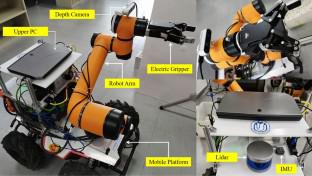Precision Agriculture ( IF 6.2 ) Pub Date : 2022-08-05 , DOI: 10.1007/s11119-022-09944-w Zhonghua Miao , Xiaoyou Yu , Nan Li , Zhe Zhang , Chuangxin He , Zhao Li , Chunyu Deng , Teng Sun

|
Agricultural robots are rapidly becoming more advanced with the development of relevant technologies and in great demand to guarantee food supply. As such, they are slated to play an important role in precision agriculture. For tomato production, harvesting employs over 40% of the total workforce. Therefore, it is meaningful to develop a robot harvester to assist workers. The objective of this work is to understand the factors restricting the recognition accuracy using image processing and deep learning methods, and improve the performance of crop detection in agricultural complex environment. With the accurate recognition of the growing status and location of crops, temporal management of the crop and selective harvesting can be available, and issues caused by the growing shortage of agricultural labour can be alleviated. In this respect, this work integrates the classic image processing methods with the YOLOv5 (You only look once version 5) network to increase the accuracy and robustness of tomato and stem perception. As a consequence, an algorithm to estimate the degree of maturity of truss tomatoes (clusters of individual tomatoes) and an integrated method to locate stems based on the resultant experiments error of each individual method were proposed. Both indoor and real-filed tests were carried out using a robot harvester. The results proved the high accuracy of the proposed algorithms under varied illumination conditions, with an average deviation of 2 mm from the ground-truth. The robot can be guided to harvest truss tomatoes efficiently, with an average operating time of 9 s/cluster.
中文翻译:

基于图像处理和深度学习的高效番茄收获机器人
随着相关技术的发展,农业机器人正迅速变得更加先进,对保障粮食供应的需求很大。因此,它们将在精准农业中发挥重要作用。对于番茄生产,收获部门雇用了超过 40% 的劳动力。因此,开发一种机器人收割机来辅助工人是很有意义的。这项工作的目的是利用图像处理和深度学习方法了解限制识别精度的因素,提高农业复杂环境下作物检测的性能。通过准确识别作物的生长状态和位置,可以对作物进行时间管理和选择性收获,缓解农业劳动力日益短缺的问题。在这方面,这项工作将经典的图像处理方法与 YOLOv5(You only look once version 5)网络相结合,以提高番茄和茎感知的准确性和鲁棒性。因此,提出了一种估计桁架番茄(单个番茄簇)成熟度的算法,以及一种基于每种方法的结果实验误差来定位茎的综合方法。室内和现场测试均使用机器人收割机进行。结果证明了所提出的算法在不同光照条件下的高精度,与地面实况的平均偏差为 2 mm。可引导机器人高效收割桁架番茄,平均作业时间为9s/簇。因此,提出了一种估计桁架番茄(单个番茄簇)成熟度的算法,以及一种基于每种方法的结果实验误差来定位茎的综合方法。室内和现场测试均使用机器人收割机进行。结果证明了所提出的算法在不同光照条件下的高精度,与地面实况的平均偏差为 2 mm。可引导机器人高效收割桁架番茄,平均作业时间为9s/簇。因此,提出了一种估计桁架番茄(单个番茄簇)成熟度的算法,以及一种基于每种方法的结果实验误差来定位茎的综合方法。室内和现场测试均使用机器人收割机进行。结果证明了所提出的算法在不同光照条件下的高精度,与地面实况的平均偏差为 2 mm。可引导机器人高效收割桁架番茄,平均作业时间为9s/簇。室内和现场测试均使用机器人收割机进行。结果证明了所提出的算法在不同光照条件下的高精度,与地面实况的平均偏差为 2 mm。可引导机器人高效收割桁架番茄,平均作业时间为9s/簇。室内和现场测试均使用机器人收割机进行。结果证明了所提出的算法在不同光照条件下的高精度,与地面实况的平均偏差为 2 mm。可引导机器人高效收割桁架番茄,平均作业时间为9s/簇。



























 京公网安备 11010802027423号
京公网安备 11010802027423号